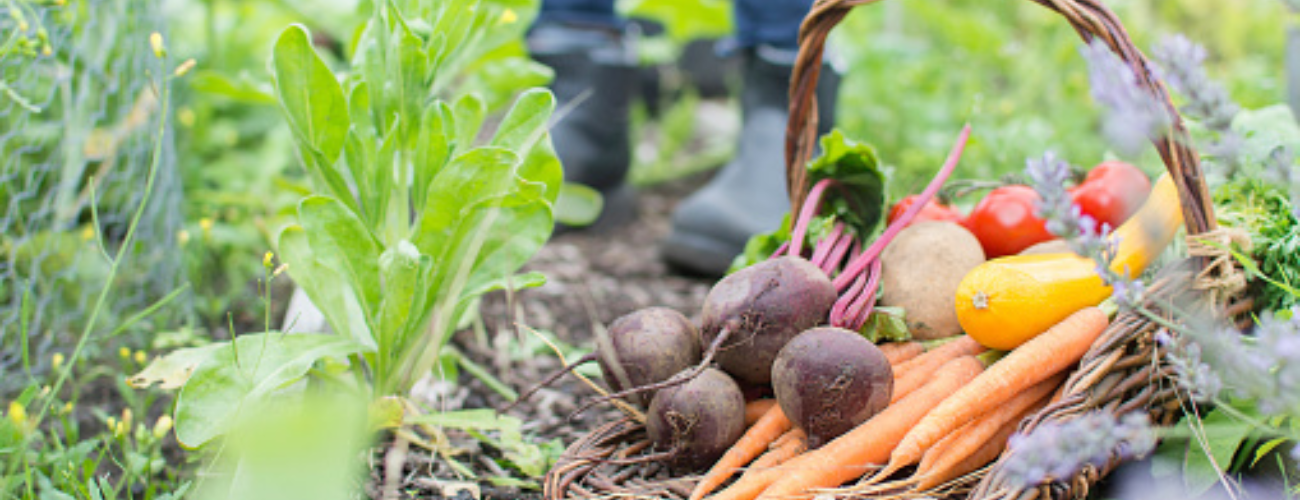With the current economic crisis, many people will be trying to make their food budget stretch further. Growing your own herbs, fruit and vegetables is a fantastic way to cheaply supplement what you buy from the supermarket. Nothing beats the flavour of home-grown, and you can guarantee your food has been grown without chemicals.
But, if you have never grown your own food before how do you decide what to grow? You will want to get the most from your time, your available space and budget. Start by grabbing a pen and paper before asking yourself the following questions:

1. What space do I have for growing?
Fruit and vegetables can be dotted in between existing plants in flower beds. Areas of lawn can be turned over to an allotment style bed. A patio area can have tubs and pots with salads and strawberries. Even a balcony will probably have space for a couple of large pots, and strawberries, salads and herbs will grow in window boxes.
If you are handy with tools and can get hold of a pallet or two, it is quite simple to make a raised bed. Fork over the bottom and add lots of multi-purpose compost mixed with some topsoil. Don’t make it too wide, you need to be able to reach the middle of the bed without walking on the soil.
Most crops do well in a sunny spot. A little shade is useful for salads or other leafy crops, they may just grow a little slower. Excessive heat and drought can make some crops like salad run to seed early. If this happens they become very bitter and not nice to eat.
To get good healthy crops your soil needs to be loose and full of organic matter. You will need to fork it over and remove any weeds. Adding a bag of multi purpose compost to enrich the soil will really help. If you are growing in pots and tubs you will need to purchase bags of compost. Multipurpose compost is fine for annual crops. For containers choose varieties that are smaller such as dwarf French beans or snub nosed carrots and check daily if they need watering. Annual herbs and salad leaves don’t need big or deep containers but smaller pots do dry out more quickly.


2. Which herbs, fruits and veg do my family and I like to eat lots of?
This question may seem a bit obvious but many people choose seeds and plug plants based on what they think will be easy or fun to grow rather than what they actually eat. Make an extensive list of what you eat regularly and think around the whole year. It may be winter right now and you are eating lots of warming soups, but what will you want to eat in July?


3. Which of these herbs, fruits and vegetables on your list are the cheapest or most expensive in the supermarket?
Sort each item into ‘cheap to buy’, ‘average to buy’ and ‘expensive to buy’. Generally people eat a lot of potatoes and carrots both of which are fairly cheap to buy. So is it worth growing them? Potatoes take up quite a bit of space and are in the ground for 4 to 6 months so it is probably not worth growing them yourself if you have limited space. Carrots grow more quickly and you can get a good crop from a small space so maybe they would be a good choice for you.
The expensive or average items need careful consideration. If you eat or would like to eat a lot of these items and they will grow in the UK without taking up too much space then these should be high up your list for growing. Lettuce for example is easy to grow if you are prepared to go snail hunting, and bagged lettuce is really expensive in the supermarkets for what you get. Lettuce is quick to go from seed to harvest and takes up very little space, it is always top of my list to grow at home.
Fruit is often in the expensive to buy column. Strawberries, raspberries and blueberries can be really expensive at the supermarket and yet don’t taste as good as home grown ones. If you like these fruits it is worth finding space for them. Strawberries and blueberries are great for containers on a patio. Blueberry plants are more expensive to buy and take a couple of years growing before they crop. It is also best to have two plants to cross pollinate for heavier cropping so these are an investment for the future. Strawberry plants are cheaper and they also produce new baby plants so you can increase the number of plants you have for free.


If your space to grow is limited – be ruthless about your choices
Go through each section of your list and think about how much space each vegetable would take up. Research spacings for planting on the back of seed packets or online. Individual cauliflower plants need lots of room so when growing your own you won’t get much return from a small space. Broccoli needs a similar amount of space, but after cutting the main head it will continue to produce smaller heads for many months. This means you get more from the same space. Broccoli is also much easier to grow, cauliflowers are somewhat temperamental. Some plants, like pumpkins, take up a lot of room and you may only get one or two pumpkins on a plant. Courgettes may take up a square metre on their own but they will crop all summer.
Some plants crop heavily without taking up much space on the ground because they grow upwards. Climbing beans and a few bamboo canes are a really good choice and the space underneath can be used by lettuce, spinach or radishes.
Make the best use of your space by growing a little but often. Sow a sprinkle of lettuce seeds every 2 weeks to spread out the harvest and avoid having a glut. Sow the fastest growing crops in between slower growing crops. Radis, for example, can be sown close to any other crop and harvested before the other crop gets too big.


Maintenance
The four most important aspects of maintaining your plants to get a good crop are: weeds, watering, feeding and pests.
Weeds
Try to keep on top of weeds. If you sow your seeds in rows you will know that anything outside of the row is a weed and can be pulled up. Weeds will use up valuable nutrients in the soil and will self seed to make more weeds. Once each week check around and pull up any you see.
Watering
Beds and borders needs to be checked twice weekly in summer, or in really hot weather, daily. Drenching the soil once each week is much better than watering a small amount daily. Anything growing in a pot needs checking every day. Water the soil not the plant, keeping the leaves dry and the soil moist. Mulching the surface with compost makes a huge difference in preventing soil from drying out and it reduces weed growth. Plants that are dry will not crop so well and are more vulnerable to pests and diseases.
Feeding
Invest in a bottle of liquid feed such as tomato or seaweed feed. Dilute it to the right strength and water the soil around your plants with it once each week. I do mine on Feedy Friday to help me remember.


Pests
Pests can really put people off but don’t panic you can expect some small losses and still get a decent crop. The main pests will be:
Slugs and snails, which on a damp night can eat their way through your salads – go on a hunt, find where they like to hide and dispose of them at least 100metres away. Reward your children for every slug or snail they find in the veg patch and make it a game. Beer traps work well if you can stop local foxes from helping themselves!
Aphids (greenfly/whitefly/blackfly) – check the tips of shoots and backs of leaves once each week and gently squish them between your fingers then wash them off. Ants may farm aphids. So if you see blackfly colonizing a runner bean plant check for ants running up and down the stem.
Caterpillars are usually only a problem on brassicas (kale, broccoli etc.) Cover those with fine mesh to stop the butterflies getting in.
Birds like strawberries and raspberries but they are not likely to do much damage.
You might find woodlice or ants in holes in your strawberries. They move into holes created by slugs or snails. Deal with the slimy critters and you won’t have a problem.
Find out what ladybird larvae and hoverfly larvae look like. These are good insects and will eat their way through lots of aphids. So if you see them leave them where they are.


Shopping List Suggestions
The list of herbs, fruit and vegetables below are suggestions that will give you a high yield within a small space and for the smallest budget. They can also all be sown directly outside with no need for starting off in modules or trays. If you can manage a little extra cost for seed trays and compost you will be able to start growing and harvesting earlier in the year.
Grow from seed:
- Lettuce (seed packets of mixed leaves)
- Climbing beans (runner beans or French beans, you will need bamboo canes or similar to create a wigwam for them to climb up and string/twine)
- Radish (from seed to harvest in as little as 4 weeks)
- Carrots (spring variety and an autumn variety)
- Spinach (perpetual spinach doesn’t run to seed so quickly and will crop for longer)
- Peas (particularly mangetout or snow peas)
- Kale (an excellent veg to sow in August to take you through the winter months)
- Beetroot (‘Bolthardy’ is a tried and trusted variety)
- Spring onions
- Swiss Chard (will keep cropping into autumn winter)
- Baby turnips
- Coriander
- Parsley
Packets of seeds start from 99p.
If you don’t have seed trays and modules we suggest you buy the following as plug plants:
- Tomato (choose an outdoor variety or a tumbling variety for a hanging basket)
- Courgettes (1 or 2 plants are sufficient for a family)
- Cucumber (choose an outdoor variety)
Other choices
- Salad or first early Potatoes grown in a big tub
- Chives and other perennial herbs are easiest bought as a pot from the herb section of your local Tates Garden Centre.
- Strawberries (growing in hanging baskets prevents slug damage)


Worth the investment
- Raspberries (Autumn varieties are easier to grow and care for. Grow a row at the back or side of a bed or in a large pot.)
- Blueberries (If you are on chalky soil grow them in a pot using ericaceous compost – You will need two plants for the best crop.)
- Vitax Liquid Seaweed feed or Tomorite
- 50 Litre bag of peat free compost from £6.99
By growing your own you can save money on expensive supermarket produce and enjoy fresh, home-grown fruit and vegetables all season long. Its lots of fun and the whole family can get involved. There has never been a better time to start!

By our resident horticultural expert











